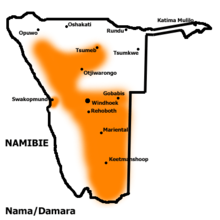Khoikhoi language
| Khoekhoe | |
|---|---|
| Khoekhoegowab | |
| Native to | Namibia, Botswana and South Africa |
| Region | Orange River, Great Namaland, Damaraland |
| Ethnicity | Khoikhoi, Nama, Damara, Haiǁom |
|
Native speakers
|
±300,000 (253 000 in Namibia) (2016) |
|
Khoe
|
|
| Dialects |
|
| Official status | |
|
Official language in
|
National language in Namibia |
| Language codes | |
| ISO 639-3 | Either: – Haiǁom – Nama |
| Glottolog | nort3245 |

The distribution of the Nama language in Namibia.
|
|
| The Khoe language | |
|---|---|
| Person | Khoe-i |
| People | Khoekhoen |
| Language | Khoekhoegowab |
The Khoekhoe language /ˈkɔɪkɔɪ/, Khoekhoegowab, also known by the ethnic term Nama /ˈnɑːmə/ and formerly as Hottentot, is the most widespread of those non-Bantu languages of southern Africa that contain "click" sounds and have therefore been loosely classified as Khoisan. It belongs to the Khoe language family, and is spoken in Namibia, Botswana, and South Africa by three ethnic groups, the Nama, Damara, and Haiǁom.
It appears that the Damara picked up the language along with the Nama in Botswana, and that they migrated to Namibia separately from the Nama. The Haiǁom, who had spoken a Juu language, later shifted to Khoekhoe. The name for Nama speakers, Khoekhoen, is from the Nama word khoe "person", with reduplication and the suffix -n to indicate the plural. Georg Friedrich Wreede was the first European to study the language, after arriving in Cape Town in 1659.
Khoekhoe is a national language in Namibia, where it is used for teaching up to the university level as well as in the public administration. In Namibia and South Africa, state-owned broadcasting corporations produce and broadcast radio programmes in Khoekhoegowab.
...
Wikipedia
